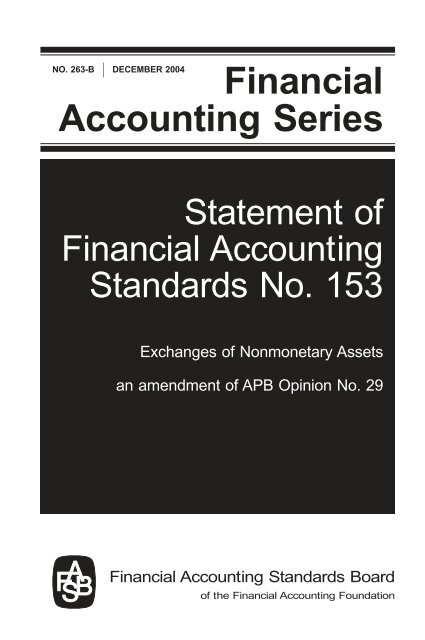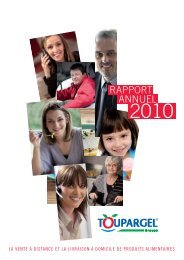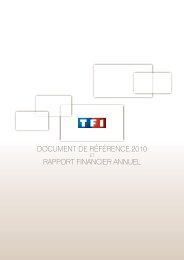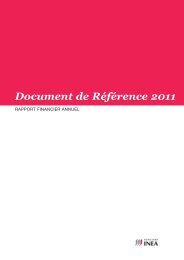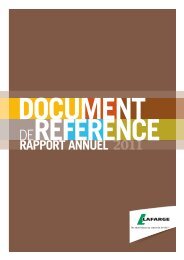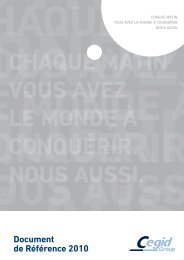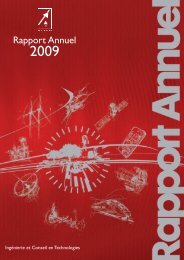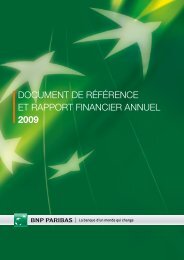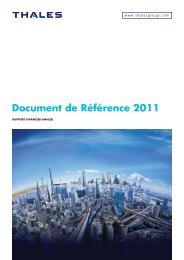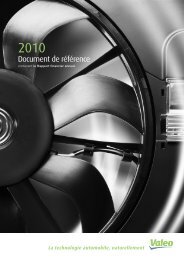Financial Accounting Series
Financial Accounting Series
Financial Accounting Series
- No tags were found...
You also want an ePaper? Increase the reach of your titles
YUMPU automatically turns print PDFs into web optimized ePapers that Google loves.
<strong>Financial</strong><strong>Accounting</strong> <strong>Series</strong>NO. 263-B DECEMBER 2004Statement of<strong>Financial</strong> <strong>Accounting</strong>Standards No. 153Exchanges of Nonmonetary Assetsan amendment of APB Opinion No. 29<strong>Financial</strong> <strong>Accounting</strong> Standards Boardof the <strong>Financial</strong> <strong>Accounting</strong> Foundation
For additional copies of this Statement and information on applicable prices anddiscount rates contact:Order Department<strong>Financial</strong> <strong>Accounting</strong> Standards Board401 Merritt 7PO Box 5116Norwalk, Connecticut 06856-5116Please ask for our Product Code No. S153.FINANCIAL ACCOUNTING SERIES (ISSN 0885-9051) is published monthly by the<strong>Financial</strong> <strong>Accounting</strong> Foundation. Periodicals—postage paid at Norwalk, CT and atadditional mailing offices. The full subscription rate is $175 per year. POSTMASTER:Send address changes to <strong>Financial</strong> <strong>Accounting</strong> Standards Board, 401 Merritt 7, POBox 5116, Norwalk, CT 06856-5116.
SummaryThe guidance in APB Opinion No. 29, <strong>Accounting</strong> for Nonmonetary Transactions, isbased on the principle that exchanges of nonmonetary assets should be measured basedon the fair value of the assets exchanged. The guidance in that Opinion, however,included certain exceptions to that principle. This Statement amends Opinion 29 toeliminate the exception for nonmonetary exchanges of similar productive assets andreplaces it with a general exception for exchanges of nonmonetary assets that do nothave commercial substance. A nonmonetary exchange has commercial substance if thefuture cash flows of the entity are expected to change significantly as a result of theexchange.Reasons for Issuing This StatementThis Statement is the result of a broader effort by the FASB to improve thecomparability of cross-border financial reporting by working with the International<strong>Accounting</strong> Standards Board (IASB) toward development of a single set of high-qualityaccounting standards. As part of that effort, the FASB and the IASB identifiedopportunities to improve financial reporting by eliminating certain narrow differencesbetween their existing accounting standards. The accounting for nonmonetary exchangeswas identified as an area in which the U.S. standard could be improved byeliminating certain differences between the measurement guidance in Opinion 29 andthat in IAS 16, Property, Plant and Equipment, and IAS 38, Intangible Assets.How the Changes in This Statement Improve <strong>Financial</strong> ReportingOpinion 29 provided an exception to the basic measurement principle (fair value) forexchanges of similar productive assets. That exception required that some nonmonetaryexchanges, although commercially substantive, be recorded on a carryover basis. ThisStatement eliminates the exception to fair value for exchanges of similar productiveassets and replaces it with a general exception for exchange transactions that do nothave commercial substance—that is, transactions that are not expected to result insignificant changes in the cash flows of the reporting entity. By focusing the exceptionon exchanges that lack commercial substance, the Board believes this Statementproduces financial reporting that more faithfully represents the economics of the transactions.Moreover, in making that amendment, the Board decided to use language thatis similar to that used in IAS 16, noting that doing so would promote more consistentapplication of the requirements of those standards.
Statement of<strong>Financial</strong> <strong>Accounting</strong>Standards No. 153Exchanges of Nonmonetary Assetsan amendment of APB Opinion No. 29December 2004<strong>Financial</strong> <strong>Accounting</strong> Standards Boardof the <strong>Financial</strong> <strong>Accounting</strong> Foundation401 MERRITT 7, PO BOX 5116, NORWALK, CONNECTICUT 06856-5116
Copyright © 2004 by <strong>Financial</strong> <strong>Accounting</strong> Standards Board. All rights reserved. Nopart of this publication may be reproduced, stored in a retrieval system, or transmitted, inany form or by any means, electronic, mechanical, photocopying, recording, or otherwise,without the prior written permission of the <strong>Financial</strong> <strong>Accounting</strong> Standards Board.
Statement of <strong>Financial</strong> <strong>Accounting</strong> Standards No. 153Exchanges of Nonmonetary Assetsan amendment of APB Opinion No. 29December 2004CONTENTSParagraphNumbersIntroduction ................................................................................ 1Standards of <strong>Financial</strong> <strong>Accounting</strong> and Reporting:Amendments to Opinion 29 ......................................................... 2Amendments to Other Pronouncements........................................... 3−6Effective Date and Transition ....................................................... 7Appendix: Background Information and Basis for Conclusions ................ A1−A27
Statement of <strong>Financial</strong> <strong>Accounting</strong> Standards No. 153Exchanges of Nonmonetary Assetsan amendment of APB Opinion No. 29December 2004INTRODUCTION1. This Statement addresses the measurement of exchanges of nonmonetary assets. Iteliminates the exception from fair value measurement for nonmonetary exchanges ofsimilar productive assets in paragraph 21(b) of APB Opinion No. 29, <strong>Accounting</strong> forNonmonetary Transactions, and replaces it with an exception for exchanges that do nothave commercial substance. This Statement specifies that a nonmonetary exchange hascommercial substance if the future cash flows of the entity are expected to changesignificantly as a result of the exchange.STANDARDS OF FINANCIAL ACCOUNTING AND REPORTINGAmendments to Opinion 292. Opinion 29 is amended as follows: [Added text is underlined and deleted text isstruck out.]a. Paragraph 3(c) and its related footnote 3:Exchange (or exchange transaction) is a reciprocal transfer between an enterpriseand another entity that results in the enterprise’s acquiring assets or servicesor satisfying liabilities by surrendering other assets or services or incurring otherobligations. 3 A reciprocal transfer of a nonmonetary asset shall be deemed anexchange only if the transferor has no substantial continuing involvement in thetransferred asset such that the usual risks and rewards of ownership of the assetare transferred.3 APB Statement No. 4, Basic Concepts and <strong>Accounting</strong> Principles Underlying <strong>Financial</strong>Statements of Business Enterprises, paragraphs 180−183, contains a more complete explanation ofexchanges and nonreciprocal transfers.1
. Paragraph 4, as amended by FASB Statements No. 71, <strong>Accounting</strong> for the Effects ofCertain Types of Regulation, and No. 141, Business Combinations:This Opinion does not apply to the following transactions:a. A business combination accounted for by an enterprise according to theprovisions of FASB Statement No. 141, Business Combinations, 3ab. A transfer of nonmonetary assets solely between companies or persons undercommon control, such as between a parent company and its subsidiaries orbetween two subsidiary corporations of the same parent, or between acorporate joint venture and its owners,c. Acquisition of nonmonetary assets or services on issuance of the capital stockof an enterprise, 4 andd. Stock issued or received in stock dividends and stock splits which areaccounted for in accordance with ARB No. 43, Chapter 7B,e. A transfer of assets to an entity in exchange for an equity interest in that entity,f. A pooling of assets in a joint undertaking intended to find, develop, orproduce oil or gas from a particular property or group of properties, asdescribed in paragraph 44 of FASB Statement No. 19, <strong>Financial</strong> <strong>Accounting</strong>and Reporting by Oil and Gas Producing Companies, as amended by FASBStatements No. 144, <strong>Accounting</strong> for the Impairment or Disposal of Long-Lived Assets, No. 145, Rescission of FASB Statements No. 4, 44, and 64,Amendment of FASB Statement No. 13, and Technical Corrections, andNo. 153, Exchanges of Nonmonetary Assets,g. The exchange of a part of an operating interest owned for a part of anoperating interest owned by another party that is subject to paragraph 47(e) ofStatement 19, andh. The transfer of a financial asset within the scope of FASB Statement No. 140,<strong>Accounting</strong> for Transfers and Servicing of <strong>Financial</strong> Assets and Extinguishmentsof Liabilities.This Opinion amends APB Statement No. 4, Basic Concepts and <strong>Accounting</strong>Principles Underlying <strong>Financial</strong> Statements of Business Enterprises, to theextent it relates to measuring transfers of certain nonmonetary assets. Someexchanges of nonmonetary assets involve a small monetary consideration,referred to as “boot,” even though the exchange is essentially nonmonetary. ThisOpinion also applies to those transactions. For purposes of applying this Opinion,events and transactions in which nonmonetary assets are involuntarily converted(for example, as a result of total or partial destruction, theft, seizure, orcondemnation) to monetary assets that are then reinvested in other nonmonetary2
assets—are monetary transactions since the recipient is not obligated to reinvestthe monetary consideration in other nonmonetary assets.c. Paragraph 20:Fair Value Not Determinable. <strong>Accounting</strong> for a nonmonetary transaction shouldnot be based on the fair values of the assets transferred unless those fair valuesare determinable within reasonable limits (paragraph 25).A nonmonetary exchange shall be measured based on the recorded amount (afterreduction, if appropriate, for an indicated impairment of value) of the nonmonetaryasset(s) relinquished, 5a and not on the fair values of the exchangedassets, if any of the following conditions apply:a. Fair Value Not Determinable. The fair value of neither the asset(s) receivednor the asset(s) relinquished is determinable within reasonable limits (paragraph25).b. Exchange Transaction to Facilitate Sales to Customers. The transaction is anexchange of a product or property held for sale in the ordinary course ofbusiness for a product or property to be sold in the same line of business tofacilitate sales to customers other than the parties to the exchange.c. Exchange Transaction That Lacks Commercial Substance. The transactionlacks commercial substance (paragraph 21).5a An indicated impairment of value of a long-lived asset within the scope of Statement 144 shallbe determined in accordance with paragraph 29 of that Statement.d. Paragraph 21 and its related footnotes 5a and 6:Exchanges. If the exchange is not essentially the culmination of an earningprocess, accounting for an exchange of a nonmonetary asset between anenterprise and another entity should be based on the recorded amount (afterreduction, if appropriate, for an indicated impairment of value) of the nonmonetaryasset relinquished. 5a The Board believes that the following two typesof nonmonetary exchange transactions do not culminate an earning process:a. An exchange of a product or property held for sale in the ordinary course ofbusiness for a product or property to be sold in the same line of business tofacilitate sales to customers other than the parties to the exchange, and3
. An exchange of a productive asset not held for sale in the ordinary course ofbusiness for a similar productive asset or an equivalent interest in the same orsimilar productive asset (similar productive asset is defined in paragraph 3and examples are given in paragraph 7). 65a An indicated impairment of value of a long-lived asset covered by FASB Statement No. 144,<strong>Accounting</strong> for the Impairment or Disposal of Long-Lived Assets, shall be determined inaccordance with paragraph 29 of that Statement.6 The fact that an exchange of productive assets is not a taxable transaction for tax purposes maybe evidence that the assets exchanged are similar for purposes of applying this Opinion.Commercial Substance21. A nonmonetary exchange has commercial substance if the entity’s futurecash flows 5b are expected to significantly change as a result of the exchange. Theentity’s future cash flows are expected to significantly change if either of thefollowing criteria is met:a. The configuration (risk, timing, and amount) 5c of the future cash flows of theasset(s) received differs significantly from the configuration of the future cashflows of the asset(s) transferred.b. The entity-specific value 5d of the asset(s) received differs from the entityspecificvalue of the asset(s) transferred, and the difference is significant inrelation to the fair values of the assets exchanged.A qualitative assessment will, in some cases, be conclusive in determining thatthe estimated cash flows of the entity are expected to significantly change as aresult of the exchange.5b FASB Concepts Statement No. 7, Using Cash Flow Information and Present Value in<strong>Accounting</strong> Measurements, contains guidance that may be useful in evaluating changes in futurecash flows.5c The configuration of future cash flows is composed of the risk, timing, and amount of the cashflows. A change in any one of those elements would be a change in configuration.5d An entity-specific value (referred to as an entity-specific measurement in Concepts Statement 7)is different from a fair value measurement. As described in paragraph 24(b) of Concepts Statement7, an entity-specific value attempts to capture the value of an asset or liability in the contextof a particular entity. For example, an entity computing an entity-specific value of an asset woulduse its expectations about its use of that asset rather than the use assumed by marketplaceparticipants. If it is determined that the transaction has commercial substance, the exchange wouldbe measured at fair value, rather than at the entity-specific value.4
21A. In the United States and some other tax jurisdictions, a transaction is notgiven effect for tax purposes unless it serves a legitimate business purpose otherthan tax avoidance. In assessing the commercial substance of an exchange, taxcash flows that arise solely because the tax business purpose is based onachieving a specified financial reporting result shall not be considered.Amendments to Other Pronouncements3. FASB Statement No. 19, <strong>Financial</strong> <strong>Accounting</strong> and Reporting by Oil and GasProducing Companies, is amended as follows:a. Paragraph 44, as amended by FASB Statements No. 144, <strong>Accounting</strong> for theImpairment or Disposal of Long-Lived Assets, and No. 145, Rescission of FASBStatements No. 4, 44, and 64, Amendment of FASB Statement No. 13, and TechnicalCorrections:In the following types of conveyances, gain or loss shall not be recognized at thetime of the conveyance, except as otherwise provided:a. A transfer of assets used in oil and gas producing activities (including eitherproved or unproved properties) in exchange for other assets also used in oil andgas producing activities. However, when proved properties are transferred inexchange for other assets also used in oil and gas producing activities, if animpairment loss is indicated under the provisions of FASB Statement No. 144,<strong>Accounting</strong> for the Impairment or Disposal of Long-Lived Assets, it shall berecognized in accordance with paragraph 29 of Statement 144.b. AIn a pooling of assets in a joint undertaking intended to find, develop, orproduce oil or gas from a particular property or group of properties, gain or lossshall not be recognized at the time of the conveyance.b. Paragraph 47(e):A part of an operating interest owned may be exchanged for a part of anoperating interest owned by another party. The purpose of such an arrangement,commonly called a joint venture in the oil and gas industry, often is to avoidduplication of facilities, diversify risks, and achieve operating efficiencies. Suchreciprocal conveyances represent exchanges of similar productive assets, and nNo gain or loss shall be recognized by either party at the time of the transaction.In some joint ventures which may or may not involve an exchange of interests,the parties may share different elements of costs in different proportions. In suchan arrangement a party may acquire an interest in a property or in wells and5
elated equipment that is disproportionate to the share of costs borne by it. As inthe case of a carried interest or a free well, each party shall account for its owncost under the provisions of this Statement. No gain shall be recognized for theacquisition of an interest in joint assets, the cost of which may have been paid inwhole or in part by another party.4. FASB Statement No. 140, <strong>Accounting</strong> for Transfers and Servicing of <strong>Financial</strong>Assets and Extinguishments of Liabilities, is amended as follows:a. Paragraph 4:This Statement does not address transfers of custody of financial assets forsafekeeping, contributions, 2 transfers of ownership interests that are in substancesales of real estate, exchanges of equity method investments for similarproductive assets, or investments by owners or distributions to owners of abusiness enterprise. This Statement does not address subsequent measurement ofassets and liabilities, except for (a) servicing assets and servicing liabilities and(b) interest-only strips, securities, retained interests in securitizations, loans,other receivables, or other financial assets that can contractually be prepaid orotherwise settled in such a way that the holder would not recover substantially allof its recorded investment and that are not within the scope of FASB StatementNo. 133, <strong>Accounting</strong> for Derivative Instruments and Hedging Activities. ThisStatement does not change the accounting for employee benefits subject to theprovisions of FASB Statement No. 87, Employers’ <strong>Accounting</strong> for Pensions,No. 88, Employers’ <strong>Accounting</strong> for Settlements and Curtailments of DefinedBenefit Pension Plans and for Termination Benefits, or No. 106, Employers’<strong>Accounting</strong> for Postretirement Benefits Other Than Pensions. This Statementdoes not change the provisions relating to leveraged leases in FASB StatementNo. 13, <strong>Accounting</strong> for Leases, or money-over-money and wrap lease transactionsinvolving nonrecourse debt subject to the provisions of FASB TechnicalBulletin No. 88-1, Issues Relating to <strong>Accounting</strong> for Leases. This Statement doesnot address transfers of nonfinancial assets, for example, servicing assets, ortransfers of unrecognized financial assets, for example, minimum lease paymentsto be received under operating leases.5. Statement 144 is amended as follows:a. Paragraph 27:A long-lived asset to be disposed of other than by sale (for example, byabandonment, in an exchange measured based on the recorded amount of the6
nonmonetary asset relinquishedfor a similar productive long-lived asset, or in adistribution to owners in a spinoff) shall continue to be classified as held and useduntil it is disposed of. Paragraphs 7–26 shall apply while the asset is classified asheld and used. If a long-lived asset is to be abandoned or distributed to ownersin a spinoff together with other assets (and liabilities) as a group and that disposalgroup is a component of an entity, 15 paragraphs 41–44 shall apply to the disposalgroup at the date it is disposed of.b. Paragraph 29 and its related footnote 17 and the heading preceding that paragraph:Long-Lived Asset to Be Exchanged for a Similar Productive Long-Lived Assetor to Be Distributed to Owners in a SpinoffFor purposes of this Statement, a long-lived asset to be disposed of in anexchange measured based on the recorded amount of the nonmonetary assetrelinquishedexchanged for a similar productive long-lived asset or to bedistributed to owners in a spinoff is disposed of when it is exchanged ordistributed. If the asset (asset group) is tested for recoverability while it isclassified as held and used, the estimates of future cash flows used in that testshall be based on the use of the asset for its remaining useful life, assuming thatthe disposal transaction will not occur. In addition to any impairment lossesrequired to be recognized while the asset is classified as held and used, animpairment loss, if any, shall be recognized when the asset is disposed of if thecarrying amount of the asset (disposal group) exceeds its fair value. 1717 The provisions of this paragraph apply to nonmonetary exchanges that are not recorded at fairvalue under the provisions those transactions described in paragraphs 21 and 23 of APB OpinionNo. 29, <strong>Accounting</strong> for Nonmonetary Transactions, as amended.for which the accounting is basedon the recorded amount (after reduction, if appropriate, for an indicated impairment of value) ofa long-lived asset exchanged or distributed.6. The provisions of this Statement partially nullify the following consensuses of theEmerging Issues Task Force (refer to the status sections of those Issues):a. EITF Issue No. 01-2, “Interpretations of APB Opinion No. 29”b. EITF Issue No. 98-3, “Determining Whether a Nonmonetary Transaction InvolvesReceipt of Productive Assets or of a Business.”7
Effective Date and Transition7. The provisions of this Statement shall be effective for nonmonetary asset exchangesoccurring in fiscal periods beginning after June 15, 2005. Earlier application ispermitted for nonmonetary asset exchanges occurring in fiscal periods beginning afterthe date this Statement is issued. The provisions of this Statement shall be appliedprospectively.The provisions of this Statement neednot be applied to immaterial items.This Statement was adopted by the unanimous vote of the seven members of the<strong>Financial</strong> <strong>Accounting</strong> Standards Board:Robert H. Herz, ChairmanGeorge J. BatavickG. Michael CroochGary S. SchienemanKatherine SchipperLeslie F. SeidmanEdward W. Trott8
AppendixBACKGROUND INFORMATION AND BASIS FOR CONCLUSIONSIntroductionA1. This appendix summarizes considerations that Board members deemed significantin reaching the conclusions in this Statement. It includes reasons for accepting certainapproaches and rejecting others. Individual Board members gave greater weight tosome factors than to others.Background InformationA2. In September 2002, the FASB and the International <strong>Accounting</strong> Standards Board(IASB) (collectively, the Boards) committed to a broad effort to improve internationalcomparability of financial reporting by working toward development of a single set ofhigh-quality accounting standards. As part of that effort, the Boards jointly undertooka short-term project to eliminate certain narrow differences between the accountingpronouncements issued by the IASB and its predecessor and the accounting pronouncementsissued by the FASB and its predecessors. Both Boards agreed to limit the scopeof the short-term project to issues for which (a) the Boards’ respective accountingpronouncements were different; (b) convergence to a high-quality solution wouldappear to be achievable in the short-term, usually by selecting between the existingstandards of either the FASB or the IASB; and (c) the issue was not within the scopeof other projects on the current agendas of either Board. The measurement basis ofcertain nonmonetary asset exchanges is one such difference that the FASB decidedshould be addressed in the short-term convergence project.A3. In May 2002, the IASB issued an Exposure Draft, Improvements to International<strong>Accounting</strong> Standards, which, among other things, proposed changing aspects of theaccounting for nonmonetary exchanges of assets in IAS 16, Property, Plant andEquipment, and IAS 38, Intangible Assets. The guidance in those two accountingstandards, as in Opinion 29, is based on the principle that nonmonetary exchangesshould be measured on the basis of the fair values of the assets exchanged. Also likeOpinion 29, those two standards contained an exception to that basic principle forexchanges of similar productive assets. The IASB’s Exposure Draft proposed eliminatingthe “similar productive assets” exception. After considering comments receivedfrom respondents on that Exposure Draft, the IASB affirmed its decision to eliminatethat exception with the added proviso that exchanges lacking commercial substance donot qualify for recognition at fair value. In October 2002, the FASB added a project to9
its agenda to consider whether to amend Opinion 29 to similarly eliminate theexception to fair value measurement for exchanges of similar productive assets.A4. In December 2003, the Board issued an Exposure Draft, Exchanges of ProductiveAssets, for a 120-day comment period, that proposed eliminating the exception to fairvalue accounting for nonmonetary exchanges of similar productive assets and replacingit with an exception for exchange transactions that lack commercial substance. TheBoard received 30 comment letters on the Exposure Draft. In September 2004, theBoard redeliberated the issues identified in the Exposure Draft and concluded that onthe basis of the existing information, it could reach an informed decision on the mattersaddressed in this Statement without a public hearing or roundtable meeting.Basis for ConclusionsReplacing the “Similar Productive Assets” ExceptionA5. In the deliberations that led to the Exposure Draft, the FASB noted that theguidance in Opinion 29 that previously required a determination of whether anonmonetary exchange is an exchange of similar productive assets was difficult toapply. For example, EITF Issues 98-3 and 01-2 provided detailed guidance forassessing whether the similar productive assets exception should apply. The Boarddecided to adopt the IASB’s approach, which bases the exception to the fair valuemeasurement principle on an assessment of the commercial substance of the exchange.The Board concluded that the IASB’s approach would (a) be more consistent with thefair value measurement principle on which Opinion 29 is based, (b) produce financialinformation that more faithfully represents the economics of the exchange, and (c) bemore easily and consistently applied. Thus, the Board proposed amendments toOpinion 29 that would eliminate the similar productive assets exception and replace itwith an exception for exchange transactions that lack commercial substance.A6. A majority of the respondents to the Exposure Draft supported the proposedreplacement of the similar productive assets exception, and the Board affirmed itsdecision in its redeliberations.Evaluating Commercial SubstanceA7. During the deliberations that led to the Exposure Draft, the FASB worked with theIASB to describe the notion of commercial substance. The Boards identified fourperspectives from which a reporting entity could evaluate commercial substance:(a) attributes of the reporting entity making the exchange, (b) attributes of the assetsbeing exchanged, (c) attributes of the counterparty to the exchange, and (d) attributes10
of the terms of the exchange. The FASB and the IASB both concluded that evaluatingcommercial substance from the reporting entity’s perspective would be the most usefulbecause such an evaluation would focus on significant changes in the economicsituation of the reporting entity as a result of the exchange.A8. Both Boards also concluded that changes to the economics of the reporting entityshould be evaluated by assessing whether the entity’s future cash flows are expected tosignificantly change as a result of the exchange—specifically, whether (a) the configurationof the future cash flows underlying the asset(s) received differs significantly fromthe configuration of those underlying the asset(s) transferred or (b) the entity-specificvalue of the asset(s) received differs significantly from the entity-specific value of theasset(s) transferred. The Board chose to require cash flow tests to determine whethercommercial substance exists because it believes those cash flow tests provide objectiveevidence of a business purpose for the transaction.A9. A number of respondents stated that they found the guidance for evaluatingcommercial substance (paragraph 21 of the Exposure Draft) difficult to apply. Paragraph21(a) would have required that entities determine whether the configuration ofthe future cash flows of the asset(s) received differed from the configuration of thefuture cash flows of the asset(s) transferred and then compare that difference to the fairvalue of the assets exchanged. Respondents noted that it may not be possible tocompare a change in configuration to the fair value of the assets exchanged because thechange may not be expressed as a dollar amount (for example, a change in timing ofcash flows). The Board agreed with those respondents and revised the guidance toeliminate the required comparison to the fair value of the assets exchanged.A10. A number of respondents to the Exposure Draft that supported the proposedamendment of Opinion 29 suggested improvements to the proposed guidance forassessing the commercial substance of an exchange. Some suggested that the Boardeliminate the cash flow tests and replace them with broader, more principles-basedguidance that describes the qualitative characteristics of a transaction with commercialsubstance. After carefully considering that suggestion, the Board affirmed its decisionto evaluate commercial substance using an approach that evaluates the risk, timing, andamounts of future cash flows and the entity-specific values of the exchanged assets. TheBoard believes that approach is more operational than one relying solely on qualitativeassessments. The Board agreed, however, that in some cases a conclusive determinationof commercial substance can be made based on a qualitative assessment rather thandetailed calculations, and guidance to that effect is included in this Statement.11
A11. The Exposure Draft proposed that a transaction would have commercialsubstance if the entity-specific value of the portion of the reporting entity’s operationsaffected by the transaction changes as a result of the exchange. A number ofrespondents to the Exposure Draft commented on that requirement, noting that it wasconfusing absent a definition for the phrase portion of the reporting entity’s operationsaffected by the transaction. In its redeliberations, the Board concluded that the use ofthat phrase was unnecessary because an entity-specific value of the asset(s) exchangedwould, by definition, include all of the cash flow effects of the transaction on the entireentity. Therefore, the Board eliminated that phrase from this Statement and replaced itwith a requirement to compare the entity-specific value of the asset(s) received with thatof the asset(s) transferred.A12. A number of respondents to the Exposure Draft suggested that this Statementinclude examples of transactions that meet the criteria for commercial substance as wellas those that do not. The Board agreed that, in some instances, example transactions canbe helpful to implement certain requirements. However, the Board decided not toinclude examples in this Statement because it believes that the additional guidancerelated to commercial substance sufficiently clarifies the meaning of that term.Additionally, the Board was concerned that example transactions might be viewed asbright lines and might restrict the appropriate use of judgment.Tax Cash FlowsA13. The Board understands that the tax rules in the United States and some other taxjurisdictions incorporate a business-purpose doctrine. Under that doctrine, a transactionis not given effect for tax purposes unless it serves a legitimate business purpose otherthan tax avoidance. The Board noted that the interaction between the commercialsubstanceexception and the business-purpose doctrine could be viewed as circular if(a) the determination of commercial substance is predicated solely on changes in taxcash flows and (b) the tax business purpose asserted is the achievement of a specifiedfinancial reporting result. The Board addressed this potential circularity by prohibitingentities from asserting commercial substance if that assertion is predicated on tax cashflows that arise solely because the tax business purpose is based on achieving aspecified financial reporting result.Changes to the Scope of Opinion 29 and Amendments to Other PronouncementsA14. Amendments to Opinion 29. The Exposure Draft proposed amending Opinion 29to explicitly exclude from its scope exchange transactions that embody a transferof assets to an entity in exchange for an interest in that entity. Although a numberof respondents to the Exposure Draft recommended that this scope exception be12
eliminated, the Board affirmed its decision, noting that including those exchanges in thescope of Opinion 29 would presuppose answers to issues being addressed in its projecton revenue recognition and in potential future projects on fresh-start measurement(new-basis accounting).A15. The Board noted that certain transactions that appear to be nonmonetaryexchanges are, in fact, not exchanges at all because the transferor does not relinquishcontrol of a transferred asset such that derecognition is appropriate. The Board did notwant this Statement to establish a less restrictive standard for gain recognition than thestandard for gain recognition that is applicable to similar transactions involvingmonetary consideration. Therefore, the Exposure Draft proposed amending the termexchange as defined in Opinion 29 to clarify that a transfer of a nonmonetary asset isnot considered an exchange for the purposes of this Statement unless the transferor hasno continuing involvement in the transferred asset. Some respondents to the ExposureDraft stated that the phrase no continuing involvement establishes a higher threshold fornonmonetary exchanges than for exchanges involving monetary consideration. Inresponse to those concerns, the Board revised that phrase to require that a transfer ofa nonmonetary asset is an exchange only if the transferor has no substantial continuinginvolvement in the transferred asset.A16. <strong>Financial</strong> <strong>Accounting</strong> and Reporting by Oil- and Gas-Producing Companies. Indeveloping the Exposure Draft, the Board concluded that the accounting for exchangetransactions described in paragraph 44(a) of Statement 19 was based on the accountingprinciples in Opinion 29. The Board therefore proposed an amendment to Statement 19clarifying that those exchanges should be accounted for in accordance with Opinion 29,as amended. Several respondents to the Exposure Draft recommended that thesetransactions be excluded from the scope of this Statement. However, the Board affirmedits decision noting that these transactions are consistent with the description of anexchange of nonmonetary assets and, therefore, are appropriately included in the scopeof this Statement.A17. The Board also noted that the transaction described in paragraph 44(b) of Statement19 is more closely analogous to an exchange of an asset for an equity interest inan entity than it is to an exchange of productive assets and, accordingly, decided thatthose transactions should continue to be accounted for under the provisions ofStatement 19.A18. The Board noted that the transactions discussed in paragraph 47(e) of Statement19 are described as exchanges of similar productive assets. The Board consideredwhether to amend that paragraph to require that those transactions be accounted forunder the provisions of Opinion 29 as amended by this Statement. The Board decidednot to amend that paragraph, noting that it is difficult to distinguish “joint venture”13
transactions from similar transactions that would be included in the scope ofStatement 19 because joint venture is not defined robustly in current guidance. Themajority of respondents agreed with that decision, and the Board affirmed it in itsredeliberations.A19. Transfers of <strong>Financial</strong> Assets. The Exposure Draft proposed amending bothOpinion 29 and Statement 140 to clarify that a transfer of an equity method investmentfor a similar productive asset should be accounted for in accordance with the provisionsof Statement 140. The majority of respondents agreed with that decision, and the Boardaffirmed it in its redeliberations.A20. FASB Statement No. 66, <strong>Accounting</strong> for Sales of Real Estate, provides guidanceon when to derecognize a real estate asset sold and when to recognize profit on the saleof that asset. Statement 66 states that exchanges of real estate for other real estateshould be accounted for under the provisions of Opinion 29. The Board consideredwhether to eliminate that scope exception in Statement 66 but decided not to do sobecause that Statement was designed to deal with transactions involving monetaryconsideration. The Board decided that the model established by this Statement isappropriate for evaluating exchanges of real estate for real estate.International Convergence of <strong>Accounting</strong> StandardsA21. Although one objective of issuing this Statement is to further the Board’sconvergence efforts with the IASB, as discussed below, some differences in accountingfor nonmonetary exchanges have not been eliminated by this Statement.A22. The FASB noted that the exception in Opinion 29 for exchanges in which the fairvalue is not determinable within reasonable limits has the same intent as the IASB’sexception for nonmonetary asset exchanges in which the fair value of the assetsexchanged is not reliably measurable. The Board decided to retain its currentterminology pending completion of its project on fair value measurement.A23. Opinion 29 provides guidance for measuring the effects of exchanges ofnonmonetary assets. IAS 16 and IAS 38 provide guidance for assessing the effects ofexchanges of property, plant, and equipment and intangible assets. Both Boardsacknowledge that those differences will likely result in scope differences between theBoards’ standards for nonmonetary exchanges. The FASB and the IASB have agreedto use an iterative process to converge the scope of their guidance for nonmonetaryexchanges. Under that process, the IASB issued its standard for nonmonetary assetexchanges with a narrower scope than this Statement. This Statement incorporatesimprovements in the notion of commercial substance as that term is used in IAS 16.14
The IASB plans to add a project to its agenda to converge its standards, in terms of bothscope and content, with that of the FASB. The Board noted that its decision to amendStatement 140 brought the scope of this Statement closer to the scope of the IASBStatements.Effective Date and TransitionA24. The Board decided that the provisions of this Statement should be effective fornonmonetary asset exchanges occurring in fiscal periods beginning after June 15, 2005.Earlier application of the provisions of this Statement is permitted so that entities basedin the European Union that report under U.S. generally accepted accounting principles(GAAP) would have the opportunity to implement its provisions prior to therequirement to report under international financial reporting standards (IFRS).A25. The Board concluded that prospective application of the provisions of thisStatement is appropriate because retrospective application in many cases may beimpracticable because it would require significant estimates as of a prior period. Insome cases, it may not be possible to objectively distinguish between information thatwould have been available at the time the affected transactions or events would havebeen recognized in the financial statements and information that arose subsequent torecognition.Benefits and CostsA26. The mission of the FASB is to establish and improve standards of financialaccounting and reporting for the guidance and education of the public, includingpreparers, auditors, and users of financial information. In fulfilling that mission, theBoard endeavors to determine that a proposed standard will fill a significant need andthat the costs imposed to meet that standard, as compared with other alternatives, arejustified in relation to the overall benefits of the resulting information. Although thecosts to implement a new standard may not be borne evenly, investors and creditors—both present and potential—and other users of financial information benefit fromimprovements in financial reporting, thereby facilitating the functioning of markets forcapital and credit and the efficient allocation of resources in the economy.A27. The Board believes that the benefits of a more conceptually based standard foraccounting for nonmonetary exchanges should outweigh the effort that would berequired on the part of preparers to determine whether a nonmonetary exchange hascommercial substance. Further, the Board notes that costs would be reduced for entitiesthat prepare financial statements for use in several jurisdictions, because convergence15
with international accounting standards will reduce the time and effort necessary toprepare reconciliations between U.S. GAAP and IFRS. The Board believes thatfinancial reporting will be both simplified and improved by eliminating the inconsistenciesbetween U.S. GAAP and IFRS.16


